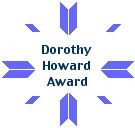About the ProjectThe Wisconsin Weather Stories project began in May 2003. Funded by the Ira and Ineva Reilly Baldwin Wisconsin Idea Endowment, this project recruited five Wisconsin K-12 classroom teachers to work with folklorists and meteorologists on the science and stories of Wisconsin weather. The folklorists, from the Wisconsin Arts Board and the UW Folklore Program, and the meteorologists, from the Department of Atmospheric and Oceanic Sciences and the Space Science and Engineering Center at UW, included five undergraduates, two professors and specialists in the two disciplines. Together this team collected local stories and meteorological data to create a curriculum that meets state academic standards in Science, English Language Arts, and the Social Studies. |

The Wisconsin Weather Stories Project was awarded the 2005 Dorothy Howard Award
which recognizes excellence in
folklore educational resources. |
The range of stories and lore on which this project focuses is broad — stories about historic events such as the Armistice Day storm of 1940, sayings about regular seasonal events, traditional expressions or proverbs about weather, observations people use for deciding where and when to catch fish, hunt deer, or plant potatoes, and stories of Wisconsin weather scientists. We looked for stories that are told especially well, in order to understand the art of storytelling. We looked for stories that highlight traditional life in Wisconsin, in order to understand the cultural basis of storytelling. We looked for stories that illustrate particular weather principles, in order to understand the science behind the stories.
The scientific analysis includes:
- reading weather maps, analyzing local variables such as temperature, moisture, cloudiness, and precipitation, analyzing concurrent larger weather systems, graphing weather reports, and making weather observations.
The folkloric analysis includes:
- identifying the traditional elements in the story related to place, ethnicity, beliefs, occupation, gender, and other factors.
The artistic analysis includes:
- identifying the artistic elements in the telling of the narrative such as use of pitch, intonation, and timing; and evaluating effectiveness of the narrative for communicating ideas.
Teacher Workshop
We held a two-day workshop in August 2003 at the UW Space Science and Engineering Center as a start to the project.
Developing the Units
Throughout the 2003-04 school year, participating teachers:
- fieldtested two interdisciplinary units on Wisconsin weather science and stories
- led their students in collecting and analyzing local weather stories
- sent the stories their K-12 students collected to the Madison team for posting to the website
During this time, the Madison team:
- developed units on severe weather stories, weather sayings, and occupational lore of weather workers
- created the website
- visited the teachers' classes to assist as needed in collecting sayings and stories
Closing Workshop
The entire group regathered for a final work session in Madison April 2004.
News Releases
Wisconsin Idea project links weather, culture and storytelling
Terry Devitt, University Communications, 9/9/03
Everybody talks about it, so why not . . .
Karen Rivedal, Wisconsin State Journal, 8/13/03






